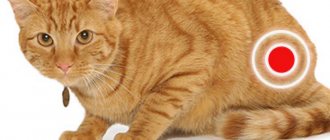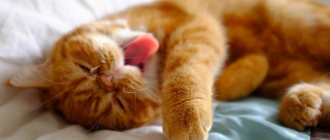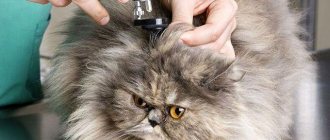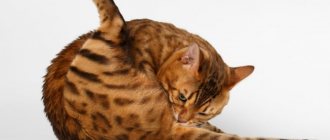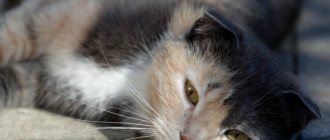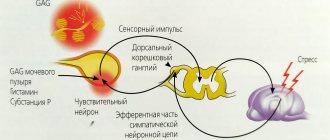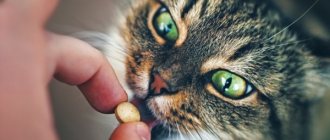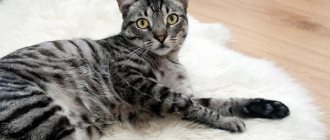Feline vestibular syndrome
Feline vestibular syndrome is a condition of the inner ear that can negatively affect your cat's sense of balance.
This disease mainly affects cats aged 12 years and older. In most cases, feline vestibular syndrome is idiopathic in nature, which means that the causes that caused it are difficult, and sometimes even impossible, to determine. With vestibular syndrome, the animal may walk staggering, fall, or lose balance. His head sometimes tilts to one side, and his eyes, as they say, begin to “run” (nystagmus). If there are any manifestations of at least one of these symptoms, then this is a reason to worry about the health of your cat.
Feline vestibular syndrome: metabolic and nutritional causes.
Taurine deficiency and hypothyroidism are two common causes of vestibular disease in cats.
Hypothyroidism causes lethargy, general weakness, weight loss, poor hair condition and possible vestibular symptoms in cats. This can lead to peripheral or central, acute or chronic vestibular syndrome. In most cases, vestibular symptoms disappear within 2-4 weeks after starting thyroxine administration...
For more information, check out our article on obesity in cats.
Vestibular disorders
The vestibular apparatus, as is known, is responsible for the correct orientation of the animal’s body and head in space in relation to ground level. Without going into details, it consists of many nerve fibers originating in the brain and ending in the inner ear. Disorders in the functioning of the vestibular system affect the brain's ability to accurately determine the position of the body. It is for this reason that a cat with vestibular disorder loses its sense of balance, tends to fall frequently, throws its head back, and is unable to walk in a straight line.
Types of vestibular disorders in cats
There are two main types of vestibular disorders in cats . They are divided into peripheral and central disorders. The central disorder occurs in the brain, and the peripheral disorder occurs in the inner ear. Usually, the central disorder has an organic cause and when it is eliminated, the disorder stops. The main symptoms of vestibular disorder in cats:
- falls;
- loss of coordination;
- tilting the head to one side;
- movement in a circle, rocking;
- stumbling on level surfaces;
- constant and frequent movement of the eyes in different directions (nystagmus).
Diagnosis of a vestibular disorder in a cat
Only a physiological examination and study of the animal’s medical history can help in diagnosing disorders of the vestibular apparatus. Along with examining the cat's inner ear, it is also necessary to conduct a full range of neurological examinations. A blood test will assess the overall health of your pet. Perhaps it will help find out the cause of the vestibular disorder. It is recommended to conduct a complete blood test, including biochemical and sugar content. It would be nice to have the results of a urine test (general and Nechiporenko) to determine the normal functioning of the liver and kidneys, to rule out the toxic nature of the disorder. If the disease cannot be diagnosed even after these tests, then a spinal tap, MRI, or x-ray of the skull may be required. If the results of these tests are negative, then central vestibular disorder can be safely excluded from the list of possible causes of the disease, despite the similarity in the manifestation of symptoms. There are quite a few options for brain damage (tumors, cysts, infiltrates, etc.) from which you can start and establish the truth of these neurological disorders.
However, since we are talking about vestibular syndrome , it is very important to determine what type of vestibular disorder your pet suffers from. And all this is definitely a prerequisite for a pet treatment program.
Diagnostic activities at the RosVet VC
If idiopathic vestibular syndrome is suspected, a thorough examination of the animal and anamnesis will be required. First, they determine what form of disorder is present, central or peripheral. A veterinary ENT doctor checks both ear canals and the eardrum, and together assesses the general neurological status of the animal.
The following are carried out as basic laboratory tests:
- Analysis of urine;
- detailed blood test (including biochemistry);
- test for feline leukemia virus;
- for immunodeficiency virus;
- for coronavirus;
- for toxoplasmosis;
- for cryptococcosis.
All these studies are necessary to assess the cat's condition and find the cause that could provoke idiopathic vestibular syndrome.
An X-ray of the head may show pathology of the ear and changes in the tympanic bulla. But this is a non-specific method and often does not show the true picture of the changes, much less all the deformations of the soft tissues.
CT and MRI are considered the best and “talking” methods in the practice of the RosVet VC, with their help you can visualize lesions in the brain or ear. In addition, in detail - lesions of soft tissues.
Treatment of vestibular disorder in cats
In general, vestibular disorders do not require treatment or require only minor treatment.
Symptomatic, as a rule. Usually, in case of nausea in an animal with this disease, drugs such as diphenhydramine, miklesin, no-spa, riabal, cerucal, etc. are recommended. They will help your pet cope with the consequences of “seasickness”. If the basis of the disease is idiopathic, then healing will take longer (several weeks).
The most important thing in case of vestibular disorder is to exclude dangerous situations when a cat can harm itself. It is advisable to visit a veterinarian at the initial stage of the disease. He can prescribe medications that will help the animal endure the disease more comfortably, and will give you competent advice.
VESTIBULAR SYNDROME IN DOGS AND CATS
A sudden loss of coordination of movements is explained by a disease of the balance organs and is called “vestibular syndrome of dogs (or cats).” Affected animals tend to lean on objects, fall, roll or move in a circle towards the affected area. Vestibular dysfunction is usually accompanied by movement in circles with a small turning radius. The head and body can sway, and the animal assumes a pose with its limbs widely spaced.
The first thing that comes to mind in such cases is that the animal is having a stroke. But stroke is perhaps the rarest cause of these symptoms. Most often, such manifestations are caused by disruption of the balance organs located outside the brain - the so-called peripheral vestibular syndrome.
The causes of peripheral vestibular syndrome are as follows:
Malformations: Congenital vestibular disease Metabolic: Hypothyroidism Tumor: Primary tumors of the auditory canal Neurofibroma of the vestibular system Infectious/inflammatory: Otitis media/internal (Otitis media), Oropharyngeal and nasopharyngeal polyps Idiopathic: Idiopathic vestibular disease (vestibular neuronitis) Trauma: Inner ear injury Toxic : Ototoxic drugs (systemic and local)
Inflammation of the middle and inner ear (otitis media) is the most common cause of peripheral vestibular syndrome. The organ of balance - the labyrinth of the cochlea - is inextricably linked with the organ of hearing. Inflammation during otitis media can spread to the cochlear labyrinth and cause disruption of its functioning. In this case, treatment should include antibiotics and anti-inflammatory drugs. Dealing with this disease can take a lot of time and effort. Symptoms of vestibular disorder disappear within 10-14 days. When treating otitis, the use of ototoxic drugs such as chlorhexidine, metronidazole and aminoglycoside antibiotics should be avoided.
Neoplasms (tumors, polyps, cysts) of the inner ear, eustachian tube, eardrum. To diagnose these formations, conventional examination and otoscopy are not enough, but additional visual diagnostic methods and cytological analysis are required. The most effective method of treating tumors is surgery.
Idiopathic vestibular syndrome is the second most common cause of balance problems. In cats, this disease occurs most often during the summer months. Cats of all ages are affected. Dogs get sick more often at older ages and regardless of the time of year. 72 hours after the onset of symptoms, a significant improvement occurs - nystagmus (rhythmic movements of the eyeballs) and nausea almost disappear, appetite and the ability to walk appear. After 7 days the animal can move normally. The head tilt can persist for a longer time - up to 2 months. No specific treatment has been developed. Recovery occurs without treatment, but recurrence of the disease is possible.
Treatment method and prognosis
Treatment of vestibular syndrome is not possible in all cases. So, if we are talking about the idiopathic nature of the pathology (congenital or acquired with age), medications are prescribed to alleviate the animal’s condition.
Pathology caused by an inflammatory infectious process is treated with antibiotics (broad-spectrum). When treating otitis, it is prohibited to use ototoxic drugs belonging to the group of aminoglycosides (antibiotics, chlorhexidine).
Vestibular syndrome caused by oncology can only be eliminated by surgery and chemotherapy. For hypothyroidism and other hormonal disorders, it is advisable to use replacement therapy.
With timely treatment, the dog’s condition stabilizes within three days. After 1-2 weeks, a decrease in ataxia and head tilt can be observed; after 3-4 weeks, recovery occurs. At this stage, physical therapy is prescribed. However, it would be incorrect to talk about a final cure.
As for prognosis, a positive one is possible only if the syndrome was diagnosed in a small puppy - there is hope that its vestibular apparatus will adapt to the environment, and the baby will be able to live a full life. In other cases, this is especially true for cancer patients, residual effects cause the animal to suffer for the rest of its life.
Vestibular syndrome in cats
Author: Karulin Petr Konstantinovich
Content
Symptoms
Feline vestibular syndrome is any process that leads to disturbances in the functioning of the vestibular apparatus in the head of an animal.
Anatomically, it is located in the inner ear, in close proximity to the brain. Therefore, the symptoms of its damage may be associated with pathologies in the structures of the latter.
If there are disturbances in the functioning of the vestibular apparatus, the animal experiences uncoordination of movements, the cat often cannot stand normally, it drifts to the sides when walking, and may fall forward or backward. There is a throwing back, and more often a tilt of the head or walking in a circle - mainly in the direction of the lesion. You can also observe nystagmus - the cat's eyes move non-stop in a horizontal, vertical direction or in a circle. In some cats, disturbances in the functioning of the vestibular apparatus may be accompanied by vomiting, as in people with motion sickness in transport.
Causes
Vestibular syndrome in cats can usually be caused by several types of diseases.
First of all, these are ear diseases. Any pathologies associated with damage to both the external auditory canal and the middle and inner ear can cause the symptoms described above. Such diseases mainly include long-term otitis media of a bacterial or fungal nature, or caused by ectoparasites. In the absence of proper treatment for a long time, inflammation from the external auditory canal can spread to the middle ear. Also, various neoplasms can be found in the ears, which can also be accompanied by inflammation of surrounding structures.
Sometimes damage to the vestibular apparatus is provoked by the owners themselves, injuring the ear canal by cleaning the ears too intensively or using inappropriate medications during treatment.
The next series of pathologies leading to vestibular syndrome in cats are brain tumors. Affecting certain parts of the structures and accompanied by edema and inflammation, tumors, in addition to vestibular symptoms, can also lead to seizures, so special attention should be paid to this group of diseases. Inflammatory processes (meningoencephalitis and encephalitis) can also affect brain structures, but in cats they are not as common.
Infectious diseases can also lead to typical symptoms of vestibular syndrome. These diseases include viral peritonitis, toxoplasmosis, viral immunodeficiency and feline leukemia virus. Unfortunately, not all of them are treatable, but nevertheless, diagnosing them is very important.
Establishing diagnosis
It will not be difficult for an experienced veterinarian to make an accurate diagnosis by analyzing the primary symptoms. However, the root cause of the disorder is more difficult to identify. The doctor may prescribe detailed instrumental and computer studies for the animal. Among them:
- MRI diagnostics of brain structures for the purpose of monitoring neoplasms and inflammation, tracking the dynamics of growth and development of tumors
- laboratory analysis of cerebrospinal fluid and blood to identify infectious diseases in a cat
- external examination of the ear canals to confirm or refute suspicions of otitis media
- otoscopy using a funnel to remove polyps, detect foreign objects, and study the condition of the eardrum
When the cause of the lesions of the vestibular apparatus is determined, the animal is prescribed a course of therapy. The duration and nature of treatment depends on the type of disease - neoplasms are removed surgically or eliminated as part of chemotherapy, infections and inflammations are treated with medications - corticosteroids, antibiotics, and other specific pharmacological drugs from veterinary medicine.
Vestibular syndrome in cats: cause, diagnosis and treatment
The word “cat” has always and at all times been synonymous with something graceful, elusively elegant and fast. And it is all the more painful to see how a recently agile and beautiful pet cannot get up, spinning in place, pathetically throwing back its head and falling out of the blue. The causes vary, but vestibular syndrome in cats is considered one of the most serious pathologies.
Diagnostics and therapy
Diagnosis of vestibular syndrome itself is quite simple, since the diagnosis is made based on clinical signs. The difficulty lies in identifying the disease that caused it all to begin.
Your veterinarian will need a comprehensive medical history; the specialist will conduct a full examination of the pet, including neurological and otoscopic examination, which are needed to identify infectious diseases, identify inflammatory processes, and tumors. Please note that in complex or doubtful cases, MRI is strongly recommended. Unfortunately, not every hospital has such equipment. It is precisely because of the difficulty of identifying the primary pathology that many cases of vestibular syndrome are considered “idiopathic.”
How is vestibular syndrome treated in cats? Treatment for this disease directly depends on the cause. It is necessary to treat the primary infectious pathology, the tumor. If the disease develops due to the abuse of any medications, stop taking them immediately. In this case, every effort should be made to remove their components from the animal’s body as quickly as possible, for which intravenous infusions of special compounds are used.
In the case of idiopathic vestibular disease, specific therapy cannot be prescribed. In this case, you must immediately place the cat in a room with a minimum amount of furniture and protruding corners. Even if the animal falls, the likelihood of serious injury will be much less. Replacement therapy may include the prescription of sedatives, as well as intravenous administration of nutritional solutions (if the animal's condition is so severe that it cannot feed itself). If a pet vomits from the constant “carousel”, she is given drugs that relieve spastic contractions of smooth muscles.
Practice shows that in cases in which the root cause of the disease is not malignant tumors in the brain, the clinical signs of vestibular syndrome weaken quite quickly and disappear completely. This largely depends on the patience and diligence of the owners of the animal, which requires careful care during periods of helplessness.
What it is?
This is what is called a disorder of the vestibular apparatus. Early clinical signs include difficulty getting up on all four legs. It seems that the cat is about to fall in the first seconds. At the same time, the animal’s head tilts to the side, and nystagmus can often be noticed. The sick cat takes a few normal steps, after which it freezes for a while, swaying, as if “gathering its thoughts.”
All this, as we have already said, is caused by disruption of the vestibular apparatus, that is, a complex organ-nervous complex that ensures the preservation of balance and orientation in space. In mild cases, violations, although they look very alarming, are in fact almost harmless. Unfortunately, everything does not always end well.
Pathology is divided into two types. The most “harmless” is peripheral vestibular syndrome in cats. This form develops when, for one reason or another, the nerve cords connecting the vestibular apparatus with the brain are affected.
The central form of the disease is much worse, since in this case the center of the lesion is localized directly in the brain, that is, in the central nervous system. This type of illness is much more severe, and the prognosis is almost always unfavorable.
By the way, how does the vestibular apparatus generally work, to which we owe the ability to walk while maintaining balance? This is a special organ located deep in the cavity of the inner ear. Consists of two special bags. The inside of the latter is lined with a special tissue with many receptors; the internal cavity is filled with endolymph.
These receptors, associated with nerves, detect the slightest changes in the “behavior” of the fluid in the organ cavity. The corresponding impulses are sent to the brain, which, based on the information received, models and corrects the position of the body in space. This process happens constantly, automatically. In cats, which are naturally predators, the normal functioning of the vestibular apparatus is especially important.
What causes the functioning of the vestibular apparatus to be disrupted, what are the symptoms?
The most common clinical symptoms of vestibular disease include: sudden falls of the animal on a completely level place, an unexplained body roll in one direction or another, a clear and constant curvature of the neck, as well as nystagmus - a rapid and involuntary oscillatory movement of the eyeballs. If the cause of the disease is severe inflammation in the inner or middle ear, a “sagging” muzzle may be observed. This is explained by the fact that the facial nerves (and, accordingly, muscles) are closely connected with the hearing organs.
The causes of this pathology can be extremely diverse, ranging in severity from spontaneously resolving to fatal. Very often the disease develops against the background of advanced meningococcal infection; its cause can be any inflammatory disease. Also in veterinary practice, there are often cases of vestibular syndrome occurring against the background of the willful use by animal owners of certain “human” antibiotics that are toxic to cats.
Remember! Giving your cat gentamicin, as well as any drugs from the tetracycline group, is strictly prohibited! Perhaps you will cure the infection, but after such “therapy” your pet may well remain disabled.
Don't forget about cysts and cancer in the brain. However, it is not so rare that the reason for what is happening can only be guessed at. This is an idiopathic vestibular syndrome. Unfortunately, in many cases there is a definite reason, but it is impossible to identify it due to a weak material base (we will mention this below).
Clinical symptoms can be found in animals of any age, sex and breed. Note that irreversible changes are quite rarely observed in cats. There are cases everywhere where symptoms disappear spontaneously within a few days. Of course, everything doesn’t always end so well; a lot depends on the timeliness of the owner’s visit to the clinic and the correctness of the prescribed treatment.
Experienced veterinarians believe that signs of “problems” of the vestibular apparatus can sometimes be seen in 20% of the litter, but after a couple of days the kittens’ behavior becomes normal. Most likely, this is due to the “adaptation” of their body to environmental conditions. The phenomenon is physiological and does not threaten the health and life of young animals in any way.
